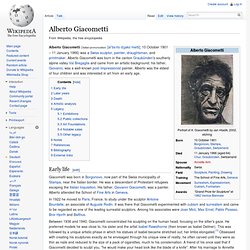

Alberto Giacometti. Alberto Giacometti (Italian pronunciation: [alˈbɛrto dʒakoˈmetti]; 10 October 1901 – 11 January 1966) was a Swiss sculptor, painter, draughtsman, and printmaker.

Alberto Giacometti was born in the canton Graubünden's southerly alpine valley Val Bregaglia and came from an artistic background; his father, Giovanni, was a well-known post-Impressionist painter. Alberto was the eldest of four children and was interested in art from an early age. Early life[edit] Giacometti was born in Borgonovo, now part of the Swiss municipality of Stampa, near the Italian border. He was a descendant of Protestant refugees escaping the Italian Inquisition.
In 1922 he moved to Paris, France, to study under the sculptor Antoine Bourdelle, an associate of Auguste Rodin. Between 1936 and 1940, Giacometti concentrated his sculpting on the human head, focusing on the sitter's gaze. His paintings underwent a parallel procedure. Later years[edit] Current 100 Swiss Franc banknote, back Death[edit] Legacy[edit] Ponic sculp - ceramic sculpture dolls.
Wassily Kandinsky. Excerpted from "Kandinsky: Compositions", by Magdalena Dabrowski Kandinsky and Music "The term "Composition" can imply a metaphor with music. Kandinsky was fascinated by music's emotional power. Because music expresses itself through sound and time, it allows the listener a freedom of imagination, interpretation, and emotional response that is not based on the literal or the descriptive, but rather on the abstract quality that painting, still dependent on representing the visible world, could not provide.
"Kandinsky's special understanding of the affinities between painting and music and his belief in the Gesamtkunstwerk, or the total work of art, came forth in his text "On Stage Composition," his play "Yellow Sound," and his portfolio of prose poems and prints Klange (Sounds, 1913). "Wagner's Lohengrin, which had stirred Kandinsky to devote his life to art, had convinced him of the emotional powers of music. Further reading on Kandinsky: Kandinsky, by Jose Maria Faerna. Abstract Expressionism. See also: CD-ROM Reviews: Painters Painting Send email to The Artchive [Art Posters][Home][Juxtapositions][Galleries][Theory and Criticism][Art CD-ROM Reviews][Artchive][Links]

Jackson Pollock. Jackson Pollock: American painter.

He was an important practitioner of Abstract Expressionism. He was born in Cody, Wyoming, into a poor sheep farming family and was originally interested in sculpture, but joined the Art Students' League of New York in 1929 and was taught painting by Thomas Hart Benton. He developed a romantic Regionalist style influenced by Ryder during the 1930s. As a member of the Federal Art project 1938-42, he met a number of avant garde artists (he exhibited with de Kooning in 1940) and discovered Picasso's work and Surrealism (he was part of the New York Surrealist exhibition in 1942 and wrote automatic poetry). In 1939, he underwent psychiatric counselling and came into contact with the ideas of Jung. Despite his abstraction, Pollock used evocative, descriptive titles for many of these works (e.g.
. - From The Bulfinch Guide to Art History The following review of the Jackson Pollock retrospective held in 1998/99 was written by Dr. Review No. 9A (excerpt) -- Joan Miro Prints. 4.kline.